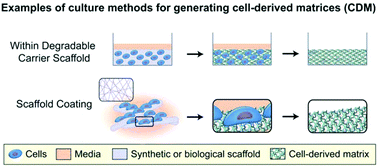Cell-derived matrices for tissue engineering and regenerative medicine applications
Abstract
The development and application of decellularized extracellular matrices (ECM) has grown rapidly in the fields of cell biology, tissue engineering and regenerative medicine in recent years. Similar to decellularized tissues and whole organs, cell-derived matrices (CDM) represent bioactive, biocompatible materials consisting of a complex assembly of fibrillar proteins, matrix macromolecules and associated growth factors that often recapitulate, at least to some extent, the composition and organization of native ECM microenvironments. The unique ability to engineer CDM de novo based on cell source and culture methods makes them an attractive alternative to conventional allogeneic and xenogeneic tissue-derived matrices that are currently harvested from cadaveric sources, suffer from inherent heterogeneity, and have limited ability for customization. Although CDM have been investigated for a number of biomedical applications, including adhesive cell culture substrates, synthetic scaffold coatings, and tissue engineered products, such as heart valves and vascular grafts, the state of the field is still at a relatively nascent stage of development. In this review, we provide an overview of the various applications of CDM and discuss successes to date, current limitations and future directions.

- This article is part of the themed collection: In celebration of Michael Sefton’s 65th birthday

 Please wait while we load your content...
Please wait while we load your content...